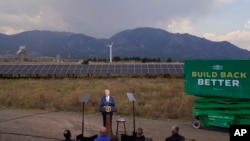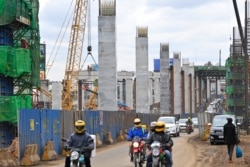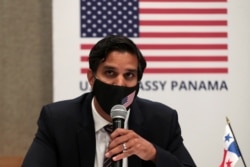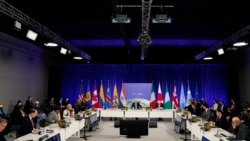U.S. President Joe Biden used the sidelines of the United Nations Climate Change Conference, also known as COP26, to push his vision for a green, collaborative global infrastructure initiative that he said will set a “sustainable path to net-zero emissions by 2050.” The plan may provide an alternative to China’s massive Belt and Road Initiative.
“The Build Back Better Initiative, the Clean Green Initiative of Great Britain, the Global Gateway and Clean Green initiatives are all part of a joint effort among the G-7 partners to deliver high-quality, sustainable infrastructure,” Biden said at a roundtable event in Glasgow, Scotland.
He and more than 100 other world leaders signed on to climate pacts to help keep global warming below 1.5° C.
Biden launched his Build Back Better World, or B3W, plan during the June G-7 summit, with the goal of creating “a values-driven, high-standard, and transparent infrastructure partnership” to help finance projects in developing countries.
That makes it an obvious alternative to Beijing’s multitrillion-dollar Belt and Road Initiative. That international development program has financed infrastructure projects in Asia, Africa and Latin America, and made inroads in Europe.
“There’s an urgent need for infrastructure development in countries — infrastructure that prioritizes, when you build it — it prioritizes the fight against climate change from the moment the spade goes in the ground, and jump-starts the green economic growth,” Biden said.
The groundwork for the U.S. initiative has already begun. Officials led by U.S. Deputy National Security Adviser Daleep Singh are in Ghana and Senegal this week to scout infrastructure projects. The “listening session” tour followed a similar trip to Latin America in September, where Singh led an interagency delegation to Colombia, Ecuador and Panama. Several other tours to different regions have been planned.
“The president’s vision for B3W is to work with partners that share our democratic values to finance and develop infrastructure in a manner that is transparent, sustainable, adheres to high standards, and catalyzes the private sector where possible,” the White House said in a statement.
But this expensive international endeavor could run into domestic difficulties. Biden’s domestic Build Back Better initiative has encountered resistance from members of his own Democratic Party, with the proposed legislation being significantly whittled down in recent weeks.
The administration has insisted the American public wants the services offered in the multitrillion-dollar infrastructure and spending plans and that Congress is holding back approval.
“They want us to get things done,” Biden said. “And that's why I'm continuing to push very hard for the Democratic Party to move along and pass my infrastructure bill and my Build Back Better bill.”
Thin on details
A formal U.S. B3W launch event is planned for early next year and will include details of some initial projects aimed at narrowing the $40 trillion needed by developing nations by 2035. But it is still unclear whether B3W can emerge as a viable alternative to the massive BRI.
“We don't have a good sense about how much money the United States will spend on it, nor the degree to which other countries will cooperate,” said Zack Cooper, a senior fellow at the American Enterprise Institute. “And we also don't have details on timelines.”
A White House official acknowledged the plan has a way to go.
“We are just starting out, while BRI has been around for years and years,” the official told VOA.
As American officials embark on their B3W tour, countries will be looking for proof that the U.S. is offering a healthier alternative to BRI, which has been tarnished by negative environmental and social impacts, a lack of transparency and corruption, and has been criticized for leaving governments around the world strangled by debt.
But it’s clear that some countries are interested in having options beyond what China can offer. Also at the Glasgow summit, major coal producer South Africa inked an $8.5 billion deal with the U.S., the European Union and other European nations to install more clean energy alternatives and to help workers who may be impacted by the shift away from coal.
In some cases, however, BRI is welcome.
Chinese investments are appealing particularly for countries with poor human rights records and high levels of corruption, precisely because its terms are more flexible and less constrained by regulations, said Lucas Myers, program coordinator for Southeast Asia at the Wilson Center's Asia Program.
The challenge for Washington is to walk the tightrope of ensuring flexibility and cost-effectiveness while upholding stricter fiscal, human rights and environmental standards, he said.
And while the administration may not be able to compete in terms of scale with BRI at this point, it appears they are aiming for investments in areas where Beijing has struggled.
“Each of the B3W's four pillars — climate, health, digital and gender — are areas in which the United States and its G-7 partners have comparative advantages,” said Jonathan E. Hillman, a senior fellow with the Center for Strategic and International Studies Economics Program.
Analysts also say that eventually the B3W may also be able to match BRI’s financial firepower — if the administration can harness private sector funding. Estimates of how much BRI costs vary widely, from as little as $1 trillion to as much as $8 trillion.
“If the United States and its partners can mobilize investments from pension funds, life insurance companies and other institutional investors, B3W could be much larger than China's BRI,” Hillman said. He added that while it will take time to prepare bankable projects, efforts like the Blue Dot Network, a U.S. State Department mechanism to certify that infrastructure projects meet robust international quality standards, could make it easier for private sector investors.
The hope is that as a track record of successful projects grows, more countries will be drawn to the initiative, Hillman said. And the impact could be exponentially greater if Washington can coordinate with other like-minded development programs.
“Japan, one of the members of the G-7, is actually the largest investor of FDI [foreign direct investment] in the region, with extensive experience and networks across Southeast Asia,” said Myers, adding that the U.S. can leverage some of Tokyo’s expertise and relationships.
The key is providing an attractive vision, compelling benefits and practical incentives, Hillman said.
The administration is planning to do just that. As the U.S. and partners start to develop and implement the plan, “robust, meaningful partnerships will be critical,” the official told VOA.
'Debt-trap diplomacy’
While the U.S. has a long track record of helping other countries build their infrastructure, including rebuilding post-war Western Europe under the Marshall Plan, the Trump administration was the first to condemn China’s international investment strategy.
In a 2018 speech, former Vice President Mike Pence accused Chinese leader Xi Jinping of expanding his influence through “debt-trap diplomacy.”
“Today, that country is offering hundreds of billions of dollars in infrastructure loans to governments from Asia to Africa to Europe to even Latin America,” Pence said. “Yet the terms of those loans are opaque at best, and the benefits flow overwhelmingly to Beijing.”
In his 2018 trip to Asia, Pence highlighted what was then the leading American alternative — the U.S. International Development Finance Corporation, a new agency with a $60 billion portfolio to support private investments for infrastructure projects around the world.
So far, the agency has not proved to be a viable alternative for BRI, with the DFC currently claiming to have 57 ongoing worldwide projects worth a total of about $2.5 billion. That may be because the initiative was wielded as a tool to achieve Trump’s short-term geopolitical goal, including in the Middle East. Investments were offered to entice countries to sign on to the Abraham Accord, Trump’s landmark deal to secure diplomatic recognition to Israel.
(VOA's Anita Powell contributed to this story.)












